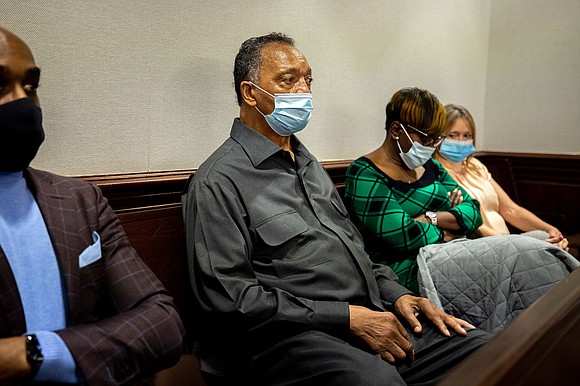Ahmaud Arbery killing trial set to continue Tuesday with testimony from medical examiner
CNN/Stylemagazine.com Newswire | 11/16/2021, 6:38 a.m.

Originally Published: 16 NOV 21 07:26 ET
By Devon M. Sayers and Alta Spells, CNN
(CNN) -- The trial over the killing of Ahmaud Arbery is expected to continue Tuesday with the testimony of a medical examiner.
Three men -- Travis McMichael, his father Gregory McMichael and William "Roddie" Bryan Jr., all of whom are White -- face charges including malice and felony murder in the death of Arbery, a Black man who was chased by the trio in vehicles and shot and killed by the younger McMichael in February 2020 near Brunswick, Georgia.
An autopsy report from April 1, 2020, found Arbery was shot three times, including twice in the chest. The manner of death is listed in the report as "homicide."
The autopsy, performed by Georgia Bureau of Investigation medical examiner Edmund Donoghue, provided additional details of the shooting, which was captured on video taken by Bryan. Arbery and Travis McMichael can be seen in the video wrestling over the firearm before the shooting.
Arbery "died of multiple shotgun wounds sustained during a struggle for the shotgun," Donoghue wrote in the autopsy report.
Arbery suffered a "deep, gaping, shotgun graze" to his right wrist, as well as wounds to his upper left chest and lower middle chest, according to the report. Thirteen shotgun pellets exited Arbery's back, and 11 more were recovered from his wounds, the report says.
The shotgun blasts also damaged his right lung and fractured his upper left arm and scapula, according to the report.
In addition to malice and felony murder, the defendants also face charges of aggravated assault, false imprisonment and criminal attempt to commit a felony. All have pleaded not guilty. If convicted, each man could face life in prison without the possibility of parole.
Arbery's family has said he was out for a jog when he was shot and killed, while defense attorneys state the three men were attempting to make a citizen's arrest before Travis McMichael shot Arbery in self-defense.
Judge appears irked by defense attorney's objections
Kevin Gough, the attorney for Bryan who apologized last week for arguing "we don't want any more Black pastors coming in here" to potentially influence the jury, complained again Monday as civil rights leader the Rev. Jesse Jackson made his first appearance in the gallery of the courtroom in support of the Arbery family.
"How many pastors does that Arbery family have? We had the Rev. Al Sharpton here earlier last week ... I don't know who Mr. Jackson, Rev. Jackson, is pastoring here," Gough said.
Sharpton had joined Arbery's parents last week and held their hands to pray together during a break in court proceedings. Sharpton has a rally and a march planned for Thursday, and Jackson has said he plans to be in court during the week.
"I guess the next question is which pastor is next? Is Raphael Warnock going to make, be the next person appearing this afternoon? We don't know," Gough said. "Your honor I would submit with all respect to the Rev. Jesse Jackson that his is not different than bringing in police officers or uniformed prison guards in a small town where a young Black man has been accused of assaulting a law enforcement officer or corrections officer."
Rev. Warnock, a US Senator for the state of Georgia, is a pastor at Ebenezer Baptist Church in Atlanta, the Rev. Martin Luther King Jr.'s former church.
Appearing bothered by the defense attorney's repeated requests, Judge Timothy Walmsley said, "Mr. Gough at this point, I'm not exactly sure what you're doing. I have already ruled on this court's position with regard to the gallery and with all candor, I was not even aware that Rev. Jackson was in the courtroom, until you started your motion."
The judge said the court's position -- not making any blanket rules over attendance as long as everyone is respectful in court -- had not changed. "It's almost as if you're just trying to continue this for purposes other than just bringing it to the court's attention," he said.
Gough later asked for a mistrial, stating that his client had been deprived of his right to a fair trial. The two additional defense teams joined in the mistrial motion, which the judge denied.
As he ruled on the motion, Walmsley called some of Gough's previous comments "reprehensible" and stressed to all the attorneys that their words were having an impact. He told them they needed to understand "that your words in this courtroom have an impact on a lot of what's going on."
Testimony reveals more details of shooting
Several investigators from the Georgia Bureau of Investigation provided information and analysis in testimony Monday.
Anne Kisler-Rao, a GBI crime lab staffer, testified that she analyzed fibers taken both from Arbery's shirt and a tape lift from a truck.
Kisler-Rao said the fibers taken from the truck were "consistent" with the fibers from Arbery's shirt, but said she could not say definitively if they came from the T-shirt Arbery was wearing.
GBI Special Agent Lawrence Kelly testified while the jury was shown enhanced versions of videos that recorded Arbery's death, providing a closer look at the shooting itself.
Wanda Cooper-Jones, Arbery's mother, closed her eyes during replays of the Bryan cell phone video, according to a pool reporter in the room. The jury kept their eyes on the video as each one was played.
Brian Leppard, a firearms and toolmark examiner for the GBI, testified he conducted a muzzle-to-target test after the state prosecutor's office requested it. The test helped to determine the approximate distance between the end of the gun and the shirt Arbery was wearing. According to Leppard, his examination of the garment showed the tearing, searing and rolling around the holes in the shirt were consistent with contact or near contact firing from the weapon.








